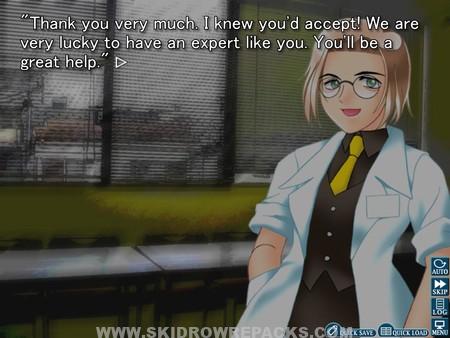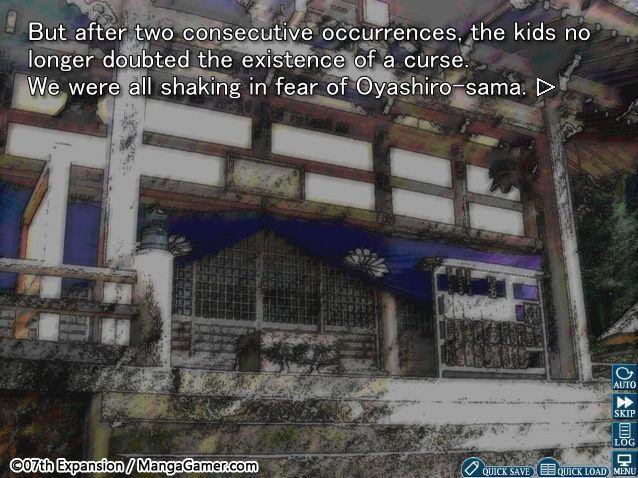After waiting a year of “TLC and editing” and a month for the mod to be updated, it’s finally here!


Higurashi Watanagashi
Higurashi: When They Cry Hou Chapter 6 – Tsumihoroboshi Review
Platform: PC
Developer: 07th Expansion
Publisher: MangaGamer
Higurashi When They Cry Hou
For those unfamiliar with the series, Higurashi centers around Hinamizawa, a mysterious remote Japanese village with dark origins that also serves as a den for supernatural and suspicious activity that is gradually revealed and expanded upon. With each game in the series being a unique scenario that follow the same general events, characters, but with plot points, concepts, and protagonists shift around with each installment. The majority of which begin with a far more innocent and fun vibe that is sharply changed into a more dark and more dismal one during the latter half of the story, when the carefree summer days of the main characters take a turn for the worse.

Tsumihoroboshi serves as the second in a series of “answer” scenarios that aim to explain and detail the true origins and ramifications seen in the first four installments. Though, unlike the fifth chapter, Meakashi, Tsumihoroboshi does not really follow or reinterpret an existing scenario. Instead it crafts a unique tale that offers insight into the psyche of the enigmatic Rena Ryuga. Detailing her background and general history while also constructing a tale rich with paranoia and suspense, in a move that harkens back to the very first scenario, Onikakushi, in many ways.
12 videos Play all Higurashi: When They Cry Ch. 6: Tsumihoroboshi Rose Matter Calling Scammers by their real names - Duration: 20:55. Jim Browning Recommended for you. Higurashi no Naku Koro ni Kai: Original title: ひぐらしのなく頃に解: Aliases: Higurashi Kai, When They Cry 2, Higu2: Length: Very long ( 50 hours) Developer: 07th Expansion: Publishers: 07th Expansion & Alchemist & Seams & Kaga Create Co. & MangaGamer & Entergram, Inc. Hinamizawa Club & MangaGamer & Seams & 07th-Mod Pbsaffran-07. Higurashi When They Cry Hou - Ch.6 Tsumihoroboshi. Description June, 1983 The summer heat has arrived earlier than it does most years. Higurashi When They Cry.
What ensues is a spirally conspiracy driven story that hops around between a series of perspectives, most notably those of the original protagonist Keiichi and Rena herself, as new information is learned about many pre-existing factors all through a story punctuated by a slew of compelling twists that go to introduce and advance the greater narrative of the series. All while on its own easily being among the better entries in the series thus far, with a number of excellent character moments and a steady pace that does not dilly dally too long with anime style shenanigans. Before culminating in an ending chapter that represents just about everything good and wonderful about this series in one concise adrenaline and emotion filled package.
If it sounds like I’m gushing about this game, it’s because I genuinely loved seeing the story progress, and how I cannot really think of any major gripes or hang-ups I have with this specific chapter. Sure, not everything from Onikakushi is explained in detail, it weirdly insists that late June is not a part of summer, and the story does introduce a lot of concepts that are clearly red herrings of sorts meant to mislead the audience prior to the final chapters. But there was no malicious child abuse, questionable sister complexes, frustratingly paced twists, or anything comparable to the hang-ups I had with earlier installments.
In fact, the game in certain ways feels like a culmination of everything that came before it with not only a number of call backs and references, but as a sequel, despite not following the same “canon” as the previous entries. One of the things that I love the most about sequels is their ability to call back and play with concepts introduced in prior installments, referencing or even subverting them in order to create a more interesting interconnected story that offers the audience a unique perspective.

My favorite example of how this is implemented, and the most obvious one, regards the five main characters. They had been through a lot in the prior games, and that is reflected here with their bonds having been hardened greatly and put to the test in a story that, at least partially, is about the bonds one forms and the power of friendship in a way that is considerably less cheesy and more heartfelt than it might sound. Furthermore, at this point I believe that both the original writer and the translation team for Higurashi really began hitting their stride, with the writing on display being at a higher level than prior entries, and the composition of certain scenes being exceptional.
Moving on, as has been established in prior reviews, Higurashi is technically known as a sound novel, which is basically a visual novel with a lighter emphasis on the visuals, as the original release of the game consisted of expressive yet amateurishly drawn sprites for the main characters, blurred photo backdrops, and a lot of black screens. Alternate sprites are made available for the western releases by MangaGamer, featuring newly drawn sprites by an artist known as Kurosaki. I personally do not care much for the glossy look many of these sprites have, the and the more exaggerated features some of them, as if the artist was trying to give the characters more sex appeal, which is a very odd choice considering how little sexualization is in the series itself.
Personally, I prefer to play these games using the 07th Mod, a tool that effectively turns the PC version of Higurashi into the more recent Playstation 3 (and Switch) release, which features a 1080p resolution, new anime-esque sprites, new backgrounds, CG artwork for specific scenes, and full voice acting for every character. It’s Japanese voice acting, obviously, but the experienced voice cast is able to bring the cast to life with each line, and it goes a long way to improving the overall atmosphere.
Since its inception, the mod has undergone numerous changes and improvements, with the more recent releases going so far as to introduce lip synching and a new visual perspective that is akin to a more traditional visual novel. I actually found this traditional look to be quite beneficial for dialog scenes, with it including names of the speakers and offering a better view of the characters. Though for a lot of lengthy exposition or monologue scenes, I prefer the original sound novel style presentation.
As the screenshots show, I am quite fond of this alteration as it places a great emphasis on the newer assets, though I am a bit bummed that the mod now switches between the HD and Kurosaki art instead of the HD and original art. I liked being able to switch over to see the potato people sprites from the original release, if only because it was interesting to see how the game’s presentation was updated over time. Also, the original sprites are cute.

Regarding the soundtrack, the Higurashi series is one that has regularly improved on the audio front as time went on and new tracks were introduced. This mentality is continued with Tsumihoroboshi, though in doing so many of the happier and more iconic tracks of this series has seemingly been replaced with ones that better support the more dour and dire storyline that is being told here. They, much like the voice acting, do an excellent job at elevating the atmosphere and general feel of the game.
Through its highs and relative lows, the Higurashi series has found numerous ways to impress me over the years I have been reviewing the recent western releases, and Tsumihoroboshi is likely my favorite entry in the series thus far. With an intriguing and suspenseful story held up high by a cast of well established characters, filled with many excellent moments and gripping reveals that left me eager to see things through to the end. All of this, paired with the presentational enhancements of the 07th Mod, I can safely say that I am excited to see how the initial saga concludes with the next two scenarios. Hopefully they won’t take a full bloody year to come out…
